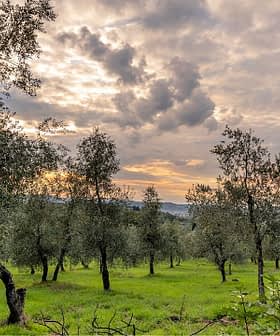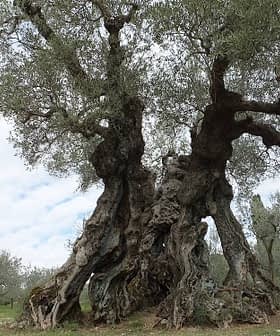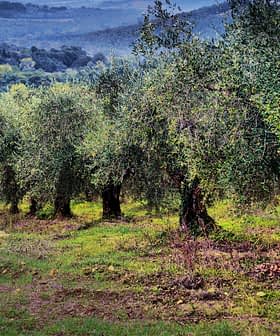ABC News Explores Effects of Climate Change on Italian Olive Oil Production
ABC news chief meteorologist Ginger Zee traveled with her crew through Italy to talk about climate change with producers and scientists during the 2016 harvest.
As climate change has emerged among the most urgent global challenges, ABC News set out to see how global warming and its some of its side effects impact Italian olive oil production in its Food Forecast series.
No matter what challenge they are faced with, they will survive because of their passion for that age-old tradition.
The journey is introduced by feeds from a drone flying over an olive grove in Agrigento, where Olio Taibi produces an award-winning monovarietal of Nocellara del Belice.
Olive Oil Times consulted ABC News for the episode of the series hosted by ABC News chief meteorologist Ginger Zee, who traveled with her crew through the Mediterranean country to meet producers and scientists during the 2016 harvest.
As Zee said, over the past few years across the globe, but definitively in Italy, there have been major challenges which led to a decrease in production, most of which were due to the weather.
“What we are seeing right now in Italy is the effect of drought,” Olive Oil Times publisher Curtis Cord observed in an interview last year at the International Culinary Center. Outbreaks of pests such as the olive fruit fly and other diseases are mainly caused by adverse climatic conditions — a key player in the “never-ending battle” faced by producers.
Despite the disruptive effects of climate and countless other headwinds, Italian producers nevertheless manage to maintain quality at the highest levels.
It is harvest time and the ABC News camera pans over an orchard in Tuscany, where olives are picked and delivered to the mill. At Olio del Colle, extra virgin olive oil pours out of the steel tube which completes the top-of-the-line process in full swing. “I’ve definitively never had fresh olive oil until right now,” Zee reveals — the sound of the machinery in the background — while savoring a dribble extra virgin olive oil on a slice of bread with the producer Flavia Paoletti.
“From the tree to your table extra virgin olive oil should be simple,” Ginger Zee affirms. “Extra virgin olive oil has to be free of what we call defects,” Cord echoes back in New York, where they taste an intense fruity extra virgin olive oil which expresses itself with a pungent sensation.
“There is also the health aspect of it, which is really the most important part,” Cord points out. “We pay more for extra virgin olive oil because we expect that it has a certain taste and certain health qualities.”
“From lowering the risk of heart diseases to benefiting levels of blood sugars, the health claims are undeniable,” Zee explains onsite at a Brooklyn olive oil retailer, O‑Live.
The next stop in Italy is Santa Téa farm, where this reporter meets the group to which I provided some logistical support. Serena and Giorgio Gonnelli take us to groves located on the hills between Florence and Siena to experience the feverish activity that is taking place among trees of Leccino, Frantoio, Moraiolo, Correggiolo and Leccio del Corno.

ABC News chief meteorologist Ginger Zee at Santa Tea farm in Tuscany (Phtoto: Ylenia Granitto)
Olives are collected with electric rakes with carbon fiber arms and crushed in a few hours. “I do think people have no idea how much effort and money it costs,” Zee realizes after using the harvest tool and gathering olives with the nets with the group of workers.
“It takes time, labor costs and production costs. That is why a bottle of authentic extra virgin olive oil cannot be cheap,” Gonnelli observes. “However, I think that the market is changing, and consumer are getting closer and closer to olive oil,” the producer considers.
At the ancient mill of the farm that dates back to 1426 you could still use granite millstones to crush olives, but despite the fascination with this antique machine, high-quality extra virgin olive oil is now produced with the latest technology.
Two years ago, the season started with ideal climatic conditions which Zee refers to with an Olive Oil Times report of that period; but then summer turned out to be very hot and humid and production decreased. “The weather is changing and it’s changing very fast,” Gonnelli concludes.
Luigi Ponti, entomologist at ENEA Casaccia Research Center, says the hope is that this one (2016/2017) will be a good season, based on the principle of biological alternation. “The olive fruit fly is a pest that is mostly driven by weather,” he affirms. “In general, you have natural enemies which control the population of agricultural pests, but in this case, that is not what happens because it is a very prolific animal. There isn’t a natural enemy that is effective enough.”
Whatever affects the fly is weather-related, as Ponti evidenced in a study estimating that by 2060 an increase in temperature in the Mediterranean would lead to an incremental increase of olive oil production in Italy and France but also to a growth of olive fly infestations.
“If you want to make quality you’ve got to spend,” points out Marina Colonna, interviewed by the ABC News team at her farm in Molise. She recently planted new olive trees of local varieties and continues to produce high-quality olive oil despite the threat of the olive fruit fly and other pests.
Colonna presents her olive trees bearing healthy fruits. “If you don’t want to spend, then it is your risk. And today, you cannot risk, because climate change is so much, that you have to be really careful,” she continues. “You have to watch your trees all the time — if you care for them. If you don’t care… anything can happen,” Colonna declares.
Probably related to effects of climate, Xylella fastidiosa is “a big issue” with plenty of controversy surrounding how to deal with it, Zee notes.
“It is a multi-factorial thing where weather, soil fertility and fungi play a role,” Ponti explains. “Now, we are seeing its spread in Corsica and Majorca and it has been found in other places,” Cord remarks. “It is something that the scientific community and the agricultural community is paying attention to. And hopefully, they will be able to prevent this serious outbreak. But, who knows.”
Despite these circumstances, the price of olive oil might not be affected as directly as most people think due to the stocks that larger producers hold to be released when the market conditions require, Cord explains. But this leads to old olive oil in the market that often isn’t as fresh as the labels indicate. “There is a harvest date, and if you can find that, that’s the best indication for the true shelf-life or the true freshness,” Cord recommends.
More and more producers are putting the harvest date on the bottle, Cord suggests as he and Zee are surrounded by olive oil bottles at a Fairway Market in Chelsea. “This at least give you a leg up and it is bettering your chance of actually getting a high-quality extra virgin olive oil. At least, it makes sure it is fresh. Once you do that, then you learn how to taste it.”
Then, back at the Culinary Center, he pours some olive oil in two blue glasses that, according to the label, should be an extra virgin olive oil but turns out to be rancid. “What you have here is something very typical that most of us are eating every day,” says Cord.
The solution is simple and lies in purchasing high-quality extra virgin olive oils, just like those made by the producers that Zee met during this journey through Italy, which are able despite the difficulties to achieve excellence.
“For me, I was lucky enough to experience the taste of real extra virgin olive oil in Italy, and after my journey, realized that, no matter what challenge they are faced with, they will survive because of their passion for that age-old tradition,” Zee concludes, while having a slice of bread with a dribble of high-quality extra virgin olive oil.









